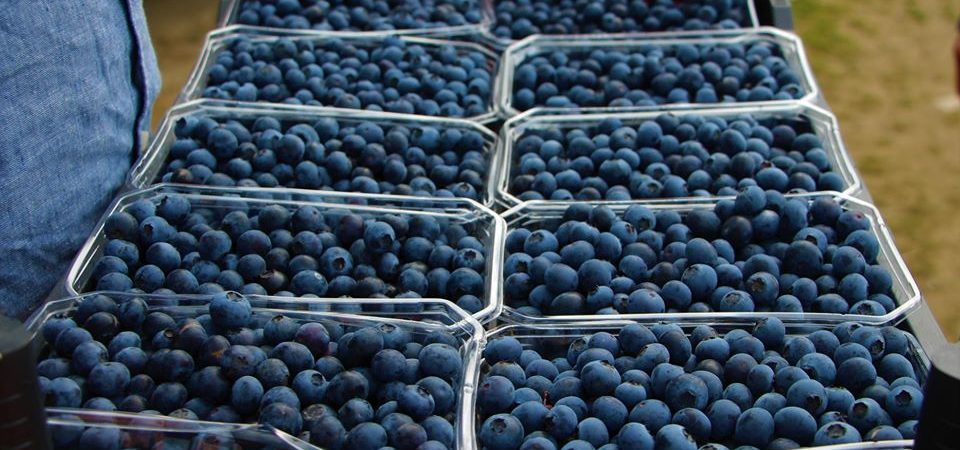Blueberry Outlook for Aggressive New Entrants: Colombia, Georgia, Ukraine, Zimbabwe, Egypt and Others
- . April 21, 2025
EastFruit team continues to analyze the global blueberry market. After covering the general global blueberry trends, as well as situation in two giants: Pery and Chile, we decided to look into the new aggressive exporters, which may seem small but are actually reshaping the global supply map.
These “aggressive new entrants” are typically countries that had negligible blueberry industries a few years ago but are now investing heavily and growing exponentially. Notably, Colombia, Georgia, Ukraine, and Zimbabwe stand out as rising stars poised to challenge more established exporters over 2025–2030.
Colombia: Colombia’s blueberry sector is in its infancy but expanding extraordinarily fast. As of 2024, Colombia exported only about 628 tons of fresh blueberries valued at $3.3 million (Colombia’s blueberry production expected to grow 669% by 2026 | Agronometrics Stories). However, the planted area is skyrocketing. The Colombian Agricultural Planning Unit (UPRA) estimates that blueberry acreage – currently around 650 hectares – could increase by 669% by 2026, reaching between 3,000 and 5,000 hectares. Columbia follows footsteps of Peru on the blueberry market. Thanks to its unique equatorial climate, Colombia can produce blueberries year-round, giving it a strategic advantage to supply counter-season markets in both North and South hemispheres.
Already, Colombian blueberries have year-round access to the U.S., Europe, and Asia, and growers are focusing on quality to make a mark. The country’s production is expected to rise sharply in the next few years. By 2030, if these projections materialize, Colombia could be producing tens of thousands of tons and exporting a major part of these berries, placing it among Latin America’s major suppliers. The government and industry are actively supporting this growth, seeing blueberries as a promising non-traditional export crop.
Georgia has leveraged its favorable climate and investment to become a fast-growing blueberry exporter in Eastern Europe. In 2023, Georgia’s blueberry exports surged 2.5-fold to reach about 2,000 tons, allowing Georgia to debut in the world’s top 20 blueberry exporters (Georgia, Zimbabwe, Ukraine – The Rise of New Blueberry Giants). Just five years ago, Georgia exported barely a few hundred tons; the average annual growth rate from 2019 to 2023 was an astounding 55%. While the absolute volumes are still modest, Georgia’s trend line is steep upwards – each year the country increased exports by ~700 tons on average, according to EastFruit. By surpassing countries like Italy, New Zealand, and even Australia in export volume, Georgia has proven its potential.
Georgian blueberries ripen in early summer and even, sometimes, at the end of May, and the industry has benefited from foreign investment and expertise, including partnerships with Dutch and Polish nurseries. If growth continues, Georgia could reach 5,000–6,000 tons of exports or more by the later 2020s, further climbing the ranks. Its proximity to high-value markets like the Middle East and EU with DCFTA trade agreement also provides advantageous logistics.
Ukraine: Despite facing the immense challenges of war and economic disruption since 2022, Ukraine’s blueberry industry has shown resilience and growth. Ukraine was already an emerging exporter pre-2020; and remarkably, in 2022 and 2023, exports accelerated sharply despite the Russian invasion. Ukraine’s exports grew by about 21% annually (adding ~530 tons per year on average) over 2019–2023. In 2022, exports jumped by +1.1k tons, and in 2023 another +940 tons, according to industry analysis by EastFruit.
Read also: From Ukrainian Fields to Global Markets: Ukrainian Blueberry Producers Unite Despite the War
Blueberry cultivation in Ukraine has expanded in the western and central regions which are relatively secure, and most of the Ukrainian berries have found their way into EU markets under trade preferences. If stability returns in the coming years, Ukraine has the land, climate and knowledge to become a major producer – even rivaling Poland in the long run. By 2030, Ukraine could potentially emerge as a significant European exporter, especially if post-war reconstruction boosts its agriculture.
Zimbabwe: Perhaps the most surprising new entrant is Zimbabwe, which has rapidly become a blueberry export success story in Africa. Virtually nonexistent five years ago, Zimbabwe’s blueberry exports now rank the country around 13th among global exporters (Georgia, Zimbabwe, Ukraine – The Rise of New Blueberry Giants). In fact, Zimbabwe led the world in export growth rate in 2022, and even averaging the past five years, it achieved about 48% annual growth in exports. Each year, Zimbabwe has been exporting 1,300 tons more than the previous year on average.
This explosive growth is driven by investment from multinational berry companies establishing farms in Zimbabwe to take advantage of its early season window. Harvesting begins earlier than in South Africa, giving Zimbabwe an advantage. Zimbabwe’s climate allows it to hit the market just as the Northern Hemisphere is ending and before other Southern suppliers’ peak, which has been extremely lucrative. With continued growth, Zimbabwe is projected to keep rising in the export rankings – it may well enter the top 10 by volume in a couple of years if current trends persist. One can foresee Zimbabwe exporting 10,000+ tons by late in the decade, further solidifying Africa’s role in the blueberry trade.
Morocco has already become a major player and is currently in the top 5 globally by export volume with steady double-digit growth, supplying Europe and beyond. While not “new” anymore, it’s part of the shifting landscape.
Egypt is another newcomer, with many companies trialing blueberry production and beginning exports; its volumes are small now but expected to grow as technical expertise improves. In fact, many blueberry market participants are very worried about Egypt’s entry into the blueberry market, remembering how fast this country has reshaped the global market of strawberries.
India is cultivating blueberries domestically and starting to export small quantities to the Middle East and SE Asia, though Indian volumes remain tiny relative to consumption. We also see countries like Ecuador and Kenya dipping toes into blueberry exports. The overarching trend is clear: blueberry cultivation has “globalized”, and new origin countries are contributing the most dynamic growth in supply. As Andriy Yarmak, FAO Economist noted: “While most attention is on the top five exporters, the most dynamic growth often occurs among countries outside the top ten, presenting new sourcing opportunities in coming years”.
These new entrants bring both opportunities and challenges to the global market. On one hand, they create new supply sources that can help meet growing demand and provide counter-seasonal fruit. For example, more year-round availability from places like Colombia or Zimbabwe could further boost consumption in importing countries. On the other hand, their rapid growth can exacerbate oversupply concerns and put pressure on prices, especially if demand doesn’t expand equally fast. Established exporters will face fresh competition; e.g., South African growers noted Zimbabwe’s rise has eaten into their early season advantage, and European growers keep an eye on Ukraine and Georgia. Ultimately, the entrance of these aggressive newcomers underscores the importance of continued market development and demand stimulation globally to ensure the expanding supply finds a home.
21.04.2025





